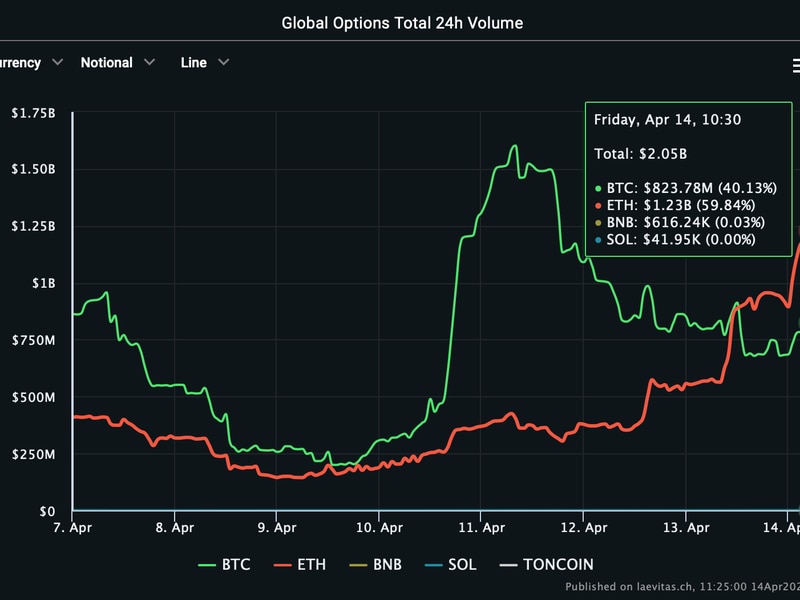Liquidity Trends Suggest ‘Uptober’ Could Be the Start of a New Crypto Bull Run
It was hard not to take notice of the “uptober” crypto rally. Bellwether BTC was up over 35% since October, and assets such as LINK and SOL are up two or three times that much.
Less explored, though, are the liquidity trends underpinning this price action. Observing these can help us gauge where we are in the cycle and thus navigate what the future market might hold.
This post is part of Consensus Magazine’s Trading Week, presented by CME.
As we highlighted for CoinDesk earlier in the year, price changes with low trading volumes are less reliable indicators than those with higher volumes. Low volumes suggest limited market participation at a particular price level, potentially leading to greater price volatility and reduced market depth.
Conversely, higher trading volumes signify broader market participation, indicating a stronger consensus and offering a more dependable basis for price movements, thereby bolstering the credibility of the signal.
Trade volume recovery in BTC and ETH, the most watched liquidity metric, is eye-catching. Two of the top-15 trading volume days since the market top two years ago were recorded during this recent rally. And most of the other high-volume days happened as dramatic company failures were taking place in 2022, or as several mid-sized U.S. banks got into difficulty in March 2023. BTC Spot volumes, which until September were breaking three-year lows, have steeply recovered and are now approaching six-month highs.
:format(jpg)/cloudfront-us-east-1.images.arcpublishing.com/coindesk/ZFC5SUW2ERAJLID47TWPM3WCM4.png)
But this is not the whole story. Digging deeper into liquidity trends can provide us further insight.
Strong action in derivatives, especially CME
Futures open interest (OI) in BTC and ETH just crossed the $20 billion mark for the first time since the FTX meltdown in November 2022, led by BTC on the back of excitement around the highly anticipated U.S. spot ETF launch.
Notably, but perhaps not surprisingly, this increase is led by institutional capital. The CME, a favorite venue for large traditional finance companies to get crypto exposure, gained the most market share across all venues and is close to overtaking Binance as the leading BTC futures exchange by OI.
:format(jpg)/cloudfront-us-east-1.images.arcpublishing.com/coindesk/VOAS3UEHZNFSVMYDWIIMBHKY2Q.png)
A similar trend can also be seen on options.
Open interest in BTC options just crossed $16 billion, and volumes are now at all-time highs. Much of this action is translated to spot prices because a relevant part of these flows is likely hedged into spot. There’s a flipside: a more pronounced derivatives market means there’s more inherent leverage in the system. So the risk of forced liquidations exacerbating price movements will likely increase from here.
Spot Order books tightened and revealed a relative lack of sellers
:format(jpg)/cloudfront-us-east-1.images.arcpublishing.com/coindesk/CDEGEMYQMZAVNIVT3HGBI3AO2U.png)
Order book depth – an alternative liquidity metric that gauges how much capital would be required to change the asset price by a certain percentage given the limit orders in place at any time – has tightened over the past few months, despite the strong price increases.
The chart below shows the 1% depth of book for BTC and ETH (top and bottom, respectively) in U.S. dollars and native units (left and right, respectively) over 2023. There is a decrease over the past 3-5 months, whichever chart you look at. And the sell side of the orderbook is trending toward shrinking by more than the buy side, suggesting a lack of sellers relative to buyers.
Busy derivatives dynamics meet a tight spot market
The chart below shows annualized realized volatility for BTC and ETH using a seven-day lookback period to capture the recent price surge. Although volatility picked up recently, it remains relatively low for both BTC and ETH, as it did not break above 63% on an annualized basis, which is below the median value during the previous bull market in 2020 and 2021.
:format(jpg)/cloudfront-us-east-1.images.arcpublishing.com/coindesk/GJZCJGAHGFFGVFQUBLBJRUH65Q.png)
This matters to liquidity because volatility usually drives higher trading activity. BTC’s current spot volumes adjusted by volatility are already in the top quartile of the 2020/2021 bull market cycle.
This rally feels different
Stronger interest from more traditional institutional investors and a market with relatively few sellers amid increasing but still relatively low volatility point to the market shifting gears to a new phase.
Looking forward, even if the possibility of interim corrections grows from there and the macro environment remains cloudy, this rally might be the start of the next bull market.
CoinDesk does not share the editorial content or opinions contained within the package before publication and the sponsor does not sign off on or inherently endorse any individual opinions.
Edited by Ben Schiller.









